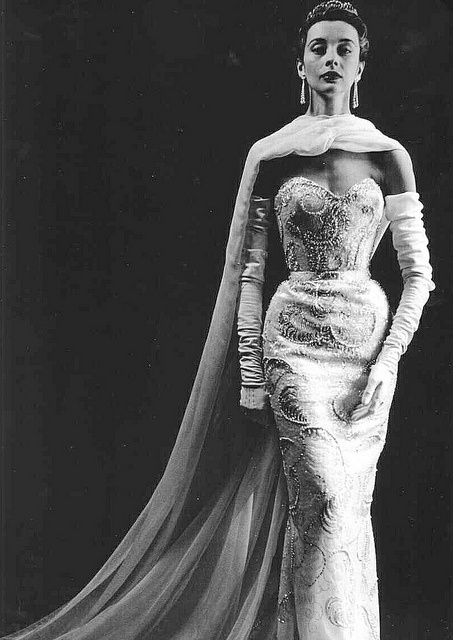1945: Paris was freshly emerged from WWII when Pierre Balmain founded his studio on 44 rue François 1er. After studying with Lucien Lelong, an haute couture master of the day, the couturier presented his very first collection on October 12 of that same year. The reviews were unanimous: a seductive breed of refinement was exuded by a restrained yet graphic use of green, brown, red, and lavender fabrics. In 1949, Balmain also launched their first perfume. Named Jolie Madame, the couturier defined it as “the perfume of adventure for evenings of passion and enchantment.” In reality, the Jolie Madame scent captures the fantastic spirit and ambiance of Parisian nights in those days. The perfume directly borrows its composition from the image of feminine sensuality itself. Floral cypresses unite with cloves, orange blossom, jasmine, and patchouli. These intense notes form a fragrance that’s synonymous with elegance and sophistication.
The perfume was such a success that Pierre Balmain called his first haute couture collection “Jolie Madame” as well. Balmain’s style would establish itself here with embroidery, shoulder pads, and a belted waist becoming the visual codes of a new femininity. A number of celebrities would vouch for the “Jolie Madame” look: through short whirling dresses with short veils for cocktail parties, the post-war Parisian style was born. This return to the opulence, charm, and elegance of noble and rare fabrics, precious and intensely worked, would soon be defined as “the new French style” by Gertrude Stein in Vogue. One need look no further than the “Jolie Madame” ball gown from 1954 in light blue satin, with a satiny opulence. On the couture side, Balmain’s suits with straight cuts and houndstooth motifs became emblematic, in addition to ball gowns, pea jackets, and ermine evening skirts – these pieces would soon find their way into the most legendary of wardrobes. Soon, Balmain’s “Jolie Madame” would take on a life of her own as an insolent and active woman.
Between 1993 and July 2002, Oscar de la Renta took over as the brand’s creative director. With his talent, he remained loyal to the essence of Pierre Balmain’s “Jolie Madame” couture. In the early 2000s, the label entered into an even more desirable modernity: with Christophe Decarnin then Olivier Rousteing, Balmain’s “Madame” became a sexy woman sporting sumptuous pieces that fit her perfectly – and more than one celebrity would succumb to the luxurious embroidered fabrics and tight waist that were the signature of “Jolie Madame” in 1952. When questioning the links between Olivier Rousteing and Pierre Balmain’s emblematic collection, with frequent accusations of vulgarity and uncontrolled opulence, the artist responds: “But my Balmain woman is a very French woman. French style isn’t just Saint-Germain-des-Prés style. My version of France is the flamboyance of Versailles, the magic of the City of Light. Poiret, Balmain, Dior, Balenciaga… they all worked with opulence. The Eiffel Tower is the exact opposite of minimalism!” In the same way, the “Jolie Madame” style is today the opposite of morose.

Leave a Reply